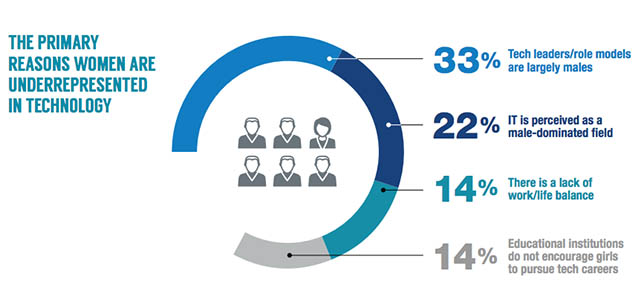Report: Lack of Mentors, Female Role Models Top List of Barriers Facing Women in Tech
Women hold only one in four technology jobs — an issue that recently has gained national attention. It’s a real chicken-and-egg situation, since the lack of women in the tech field discourages other women from entering the field. To add to the problem, those who do enter tech fields haven’t always had the best experiences, with many reporting gender bias in the workplace and unequal opportunities compared to their male counterparts.
Those findings come from the ISACA (Information Systems Audit and Control Association), an independent, nonprofit, global business and technology association. Ahead of International Women’s Day this Wednesday, ISACA released “The Future Tech Workforce: Breaking Gender Barriers,” a report from its global survey of more than 500 women working across a range of tech industries.
The report looks at why women are underrepresented in the field and identifies the top five barriers experienced by women in tech as follows:
- A lack of female mentors (cited by 48 percent of respondents);
- Lack of female role models in the tech field (42 percent);
- Gender bias in the workplace (39 percent);
- Unequal growth opportunities for women compared to men (36 percent); and
- Unequal pay for the same skills (35 percent).

When participants were asked why it might be that women are so underrepresented in tech fields, the No. 1 answer is that IT role models and leaders are predominantly male. Image Credit: ISACA.
A majority of respondents (87 percent) said they are “somewhat or very concerned about the number of women in the technology sector,” according to the report. ISACA said “limited networking opportunities” and “lack of strong professional network” contribute to the problem, as women hunger to learn from the presence of other women in tech.
“Women are vastly underrepresented in the global technology workforce. This is not only a societal concern, but also a workforce problem, given the critical shortage of skilled technology professionals faced by many enterprises,” said Jo Stewart-Rattray, board director of ISACA and director of information security and IT assurance at BRM Holdich, in a prepared statement.
Furthermore, the study found that gender bias is pervasive in the tech field: Only 8 percent of survey respondents said “they have never experienced gender bias in the workplace.” Bias can take various forms, from being overlooked at meetings to having ideas dismissed to inexplicably being passed over for promotions. About 27 percent of those surveyed said “they often or always experience gender bias.”
Men outnumber women at every level in the tech sector, but the starkest differences are at the top, with only 21 percent of tech executives being female. When ISACA asked participants about professional development opportunities, about 80 percent reported their employers are male, yet 75 percent said their employers lacked a gender leadership development program.
Finally, women have still not reached wage parity with men. ISACA cites a PayScale report that women in tech are paid 18 to 22 percent less than what men earn. Based on its own survey, ISACA found 43 percent of women are being paid less than men with equal skills and experiences. No respondents said they are paid more.
ISACA noted that women need the same kind of tools, support and training men do to succeed in tech careers,” highlighting a few grassroots efforts to equip women with tech skills. The nonprofit organization Girls Who Code, for example, provides internships and fellowships and encourages young girls to explore computer science degrees and careers. Melinda Gates from the Bill & Melinda Gates Foundation is also committed to getting more women into computer science.
“ISACA’s survey findings reinforce that there is much work left to be done. By providing more opportunities, including career advancement programs, we can make long overdue progress in ensuring that women are more equitably represented in the technology workforce,” Stewart-Rattray said.
ISACA is planning several educational opportunities related to its Connecting Women Leaders in Technology program. Its next webinar is scheduled for May 18 and ISACA’s North America CACS conference will take place May 1-3 in Las Vegas.
The full report is available on the ISACA site.
About the Author
Sri Ravipati is Web producer for THE Journal and Campus Technology. She can be reached at [email protected].